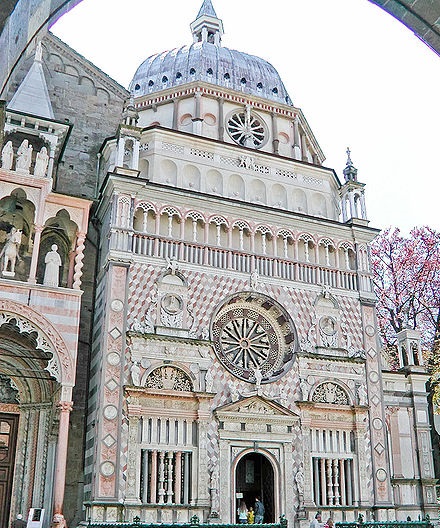
Colleoni Chapel – Symbols, curiosities and mysteries
The Colleoni Chapel was built between 1472 and 1476 as a mausoleum for the leader Bartolomeo Colleoni.
In Colleoni’s original idea, the chapel was not meant to remain “confined” in the small square of the Cathedral. It was destined to become the pivot of the space in Piazza Vecchia. In fact, the leader had planned to pull down the Palazzo della Ragione, considered a decrepit medieval building.
His desire for greatness was only partially fulfilled but left visible traces behind. Just look at the facade of the chapel, located next to the medieval prothyrum of Santa Maria Maggiore. The former is significantly higher than the latter, marking the hierarchical dominance imagined by Colleoni.
The Colleoni Chapel is marked by many sculptures of symbolic meaning, which are placed on the front of the mausoleum. At the sides of the entrance, the two female figures on the columns represent Strength and Constancy, virtues referable to Colleoni himself. While a blessing Eternal Father appears in the tympanum just revealed by three angels. The one in the middle rests on the condottiero’s coat of arms, which is therefore at the center of the façade. If you look along the central axis, you can identify the figure of Saint Alexander above the rose window. The saint is the patron warrior of Bergamo with whom Colleoni could easily be identified. Finally, four other Virtues rest on the trabeation of the two windows.
Besides being a highly symbolic place, the Colleoni Chapel has also been the subject of a little mystery. A mystery that lasted until 1969.
For centuries it was believed that the body of Bartolomeo Colleoni was not in the mausoleum but in some other place. This was because his sarcophagus was said to be empty at every inspection. This had fed an exciting historical mystery about the fate of the remains of the leader. It also came to the rumor of moving the coffin from the ark to another site. Someone even spoke of the floor of Santa Maria Maggiore, by order of none other than Saint Charles Borromeo.
In reality, as it was ascertained in 1969, the Colleoni really rests in his mausoleum. However, he was buried in his monument two months after his death because at that date it had not yet been completed. Hence the origin of the legend.
Did you like this curiosity? If you want to read more, about thousands of cities, download Secret Maps!
And if you want to listen to something interesting, try the first Travel Podcast Platform. Try Loquis!

